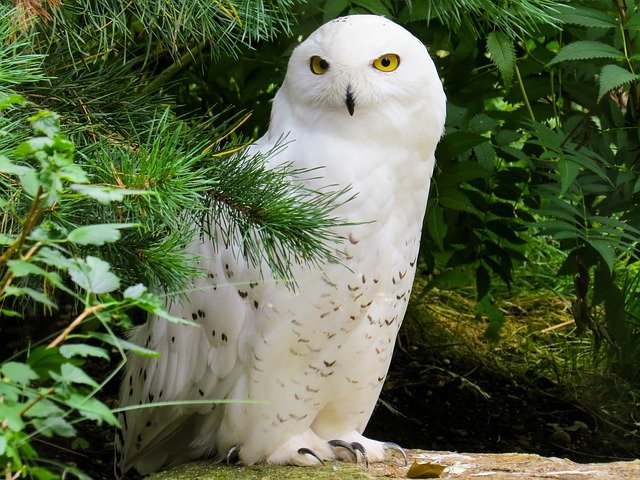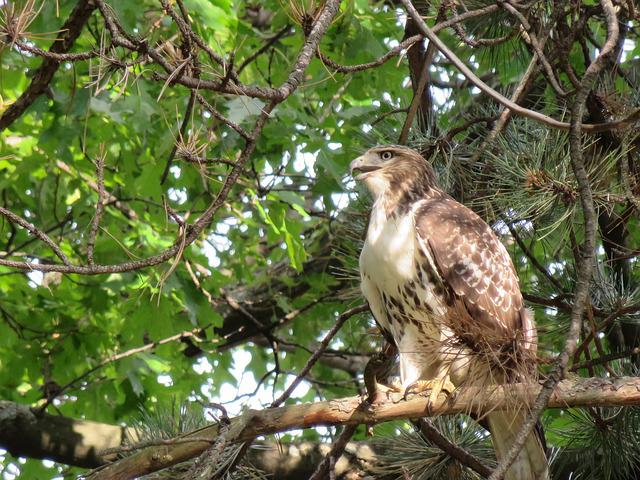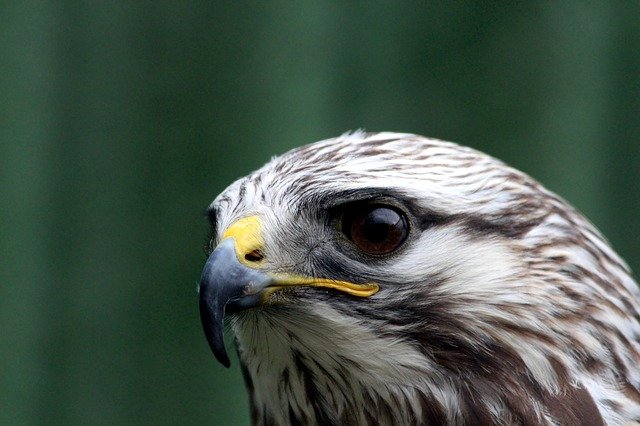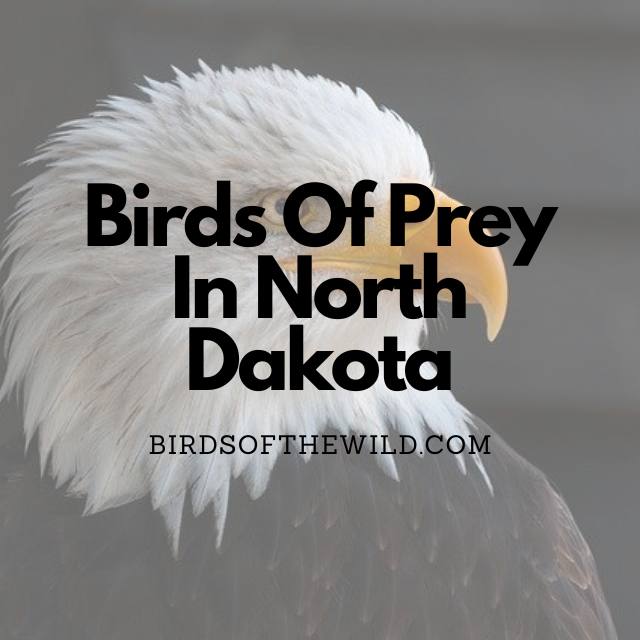In this article I’ll be going over 13 birds of prey that can be found scattered throughout North Dakota so, continue reading for a more detailed look at each of these birds below.
- Bald Eagle
- Cooper’s Hawk
- Turkey Vulture
- American Kestrel
- Golden Eagle
- Snowy Owl
- Great Horned Owl
- Red Tailed Hawk
- Broad Winged Hawk
- Osprey
- Sharp Shinned Hawk
- Rough Legged Buzzard
- Eastern Screech owl
13 Birds Of Prey In North Dakota
1. Bald Eagle (Haliaeetus Leucocephalus)

- Size: 90 – 108cm
- Weight: 3 – 6.3kg
- Wingspan: 180 – 250cm
Bald eagles are fall and winter non-breeding residents in southwest North Dakota.
A bald eagle’s plumage consists of dark brown around its wing and body, with white feathers on its tail and head along with the trademark yellow beak and feet. Both male and female bald eagles look relatively the same.
As for where you can find these eagles, it will often be around lakes and reservoirs with lots of fish and surrounding forests. You’ll often find them around unfrozen lakes and hunting along coastlines, reservoirs, and rivers during the winter months
These eagles are birds of prey meaning they hunt other birds, medium sized mammals like rabbits, hares, other animals like reptiles, fish and even eat carrion when their options are limited. Sometimes bald eagles are recognised as fish eagles as their diet consists of fish and as meat is the only thing they eat these eagles would ultimately be regarded as carnivores too.
Bald eagles can live for around 20 years in the wild.
2. Cooper’s Hawk (Accipiter Cooperii)

- Size: 35 – 51cm
- Weight: 400 – 700 grams
- Wingspan: 73 – 94cm
You’ll find cooper’s hawks across the majority of North Dakota when breeding.
Cooper’s hawks are recognised by their gray back and upper head with a orange and white patterned breast, legs and underside of the wing. The females and males look very much the same but, the females are around 30% larger than the opposite gender.
You’ll often find a cooper’s hawk around pines, oaks, Douglas-firs, beeches, spruces, and other tree species, often on flat ground rather than hillsides, and in dense woods.
As for what they eat, it includes mainly medium-sized birds including robins, jays, flickers, among other smaller and even larger birds. Small mammals like chipmunks, tree squirrels, ground squirrels, mice, bats, etc. are included in their diet too.
Cooper’s hawks tend to live for around 10 – 12 years on average whilst the oldest recorded hawk surpassed the 20 year mark.
3. Turkey Vulture (Cathartes Aura)

- Size: 62 – 81cm
- Weight: 1.5 – 2 kg
- Wingspan: 1.6 – 1.8m
You’ll find turkey vultures across all of North Dakota in their spring and summer breeding season.
Turkey vultures have a plumage that is mostly brownish/black in color with silver/gray lining on the underside of their wings adding a contrast to their overall appearance. The face is pink/red with elements of black on the head topped of with a pale white beak.
These scavengers are mono-morphic so they do look the same with the only differentiating aspect being their sexual organs.
Turkey vultures are scattered throughout north America where they can be found staying within open and forested habitats where they will also stay within lower elevation mountain ranges.
Carrion is a turkey vultures primary food source but, they do also eat dead reptiles, birds, amphibians and invertebrates. As a whole these vultures do prefer fresher carrion but, like other vultures they can consume the same carcass over several days.
Turkey vultures are known to live for around 16 years in the wild and up to 30 years in captivity.
4. American Kestrel (Falco Sparverius)

- Size: 20 – 24cm
- Weight: 115 – 125 grams
- Wingspan: 50 – 60cm
These American kestrels can be found all across North Dakota in their spring and summer breeding seasons.
American kestrels are recognised by their spotted orange, gray, black and white plumage with their back orange with a black horizontal pattern, their wings a gray color, black tail feathers and orange sides with a gray and white head that has 2 black lines drawn vertically near both eyes. Females are mostly light brown.
American kestrels can be found in a variety of open or semi-open habitats from forest clearings, farmland and deserts.
As for what they eat, it includes small mammals such as woodmice and shrews, small birds, insects, earthworms with voles being their go to food source.
Wild American kestrels are known to live for around 5 years but, captive variants have been known to hit 17+ years.
5. Golden Eagle (Aquila Chrysaetos)

- Size: 70 – 82cm
- Weight: 3.7 – 5.3kg
- Wingspan: 190 – 212cm
Golden eagles can be found in western North Dakota on year round basis and in the remainder of the state when in the fall and winter non-breeding months.
These eagles are recognised by their mostly light brown and dark brown plumage, yellow feet and black downwards pointing beak. Females once again are the larger of the 2 birds where males are roughly 33% smaller in size.
These eagles spend the majority of their time within open moorlands and mountains within the likes of Scotland, and many areas within north America
Golden eagles do eat carrion but, it isn’t their first choice of food when hunting for prey. If they do find a dead carcass they will eat it, with their general food choices consisting of smaller mammals, birds and sometimes larger prey.
These eagles are known to live for around 14 years in the wild whilst captive are even able stay alive till their early 30’s with the longest observed at 32 years old.
6. Snowy Owl (Bubo Scandiacus)

- Size: 52 – 71cm
- Weight: 1.1 – 2kg
- Wingspan: 125 – 164cm
Snowy owls can be found all throughout North Dakota in their non-breeding fall and winter months.
These owls are recognised by their mostly white plumage with brown dots throughout the body. Females on the other hand are generally less white than the males as the brown spots encompass more of their body.
Snowy owls tend to spend their time within arctic tundra or open grasslands and fields, whilst avoiding forested areas.
As for what they eat, it includes lemmings and a variety of small mammals. Nevertheless, they will still occasionally eat larger mammals like like hares, rats, rabbits, etc.
Snowy owls have been observed to live for around 28 years in captivity and between 10+ years in the wild.
7. Great Horned Owl (Bubo Vrginianus)

- Size: 57 – 63cm
- Weight: 1.4 – 1.5kg
- Wingspan: 1.35 – 1.5m
Great horned owls can be found all across North Dakota on a year round basis.
These large horned owls are recognised by their brown/gray plumage with their defining feature being the tuft of feather on the top of their head resembling a horn or ear like feature. Male and female great horned owls look relatively the same with the females slightly larger in size.
At night these birds will perch on a branch or a tall building to look around for prey and once the desired prey has been found they will fly towards it with folded wings, grab the prey with their talons piercing through their body and in most cases killing them immediately.
As for what these birds eat it includes smaller prey like rodents, frogs or scorpions. Even other larger predators like geese, ducks, hawks, and smaller owls can be eaten by these carnivorous birds.
Great horned owls are most commonly found in deserts, wetlands, forests, grasslands, backyards, cities and they can also be found in semi-open habitats between the Arctic and the tropics.
As for a great horned owls lifespan, it can be anywhere from 15 -25 years.
8. Red Tailed Hawk (Buteo Jamaicensis)

- Size: 45 – 60cm
- Weight: 1.25 – 1.47kg
- Wingspan: 100 – 150cm
Red tailed hawks are spring and summer breeding residents in all of North Dakota.
These hawks are recognised by their brown torso and wings, white breast and red tails. The main difference between the male and females is that the females are a third larger than the males.
These red tailed avians spend their time at a variety of places within the state including deserts, grasslands, forests, agricultural fields and urban areas.
Red tailed hawks are carnivorous birds of prey where they feed on small mammals, rodents, other smaller birds, fish and even carrion.
In the wild red tailed hawks are known to live between 15 – 20 years whilst captive red tails can live on the upper end of that spectrum around 20 years.
9. Broad Winged Hawk (Buteo Platypterus)

- Size: 32 – 44cm
- Weight: 265 – 560 grams
- Wingspan: 74 – 100cm
Broad winged hawks can be found in North Dakota’s eastern border throughout their breeding season and in the remainder of the east and central regions when migrating
These hawks are recognised by their darker brown wings, patterned white and light brown chest, a face light brown in color and legs yellow in color. Females in this case look very similar to the males but, are just the bigger of the two genders.
Broad winged hawks will typically stay around dense, unbroken deciduous or mixed deciduous/coniferous woodlands.
As for what they eat, it includes a large variety of food sources such as small mammals, amphibians, reptiles, like mice, voles, squirrels, toads, frogs, snakes, lizards, young turtles; various small birds; large insects and even crayfish, fish, centipedes, earthworms.
In regards to lifespan, broad winged hawks tend to live for 12 years with the oldest recorded said to have lived for 14 years and 4 months.
10. Osprey (Pandion Haliaetus)

- Size: 50 – 65cm
- Weight: 1 – 1.5kg
- Wingspan: 170 – 185cm
Ospreys can be found in all of North Dakota when migrating.
Ospreys are recognised by their brown wings and back, white neck and belly with hints of brown around the neck, with a black beak and yellow eyes. The male and females are very similar in appearance although the females are roughly 20% larger.
Ospreys can be found around large watercourses such as rivers, lakes or coastal areas.
As for what they eat, it includes mostly fish from medium-sized fish such as salmon, trout, flounder and mullet, along with the odd smaller ones too.
These big birds have been observed to live for around 15 – 20 years on average with the longest recorded age being 32 years.
11. Sharp Shinned Hawk (Accipiter Stratus)

- Size: 23 – 37cm
- Weight: 82 – 220 grams
- Wingspan: 42 – 68cm
Sharp shinned hawks are breeding residents in central and eastern North Dakato whilst they will generally fly through the other parts of the state when migrating.
These hawks are recognised by their gray wings and back, brown and white breast and belly with a pair of yellow feet. Females look very similar to the males but are roughly a third larger.
Sharp shinned hawks can be found around mixed or coniferous forests, open deciduous woodlands, thickets, edges
These hawks will often eat birds from the size of a sparrow up to that of a robin’s size and in rare occasions some birds that are the size of quails too. They also eat the occasional rodent, bats, squirrels, lizards, frogs, snakes, and large insects.
Sharp shinned hawks will typically live for around 5 – 6 years on average, although some are able to live 10+ years in the right environment.
12. Rough Legged Buzzard (Buteo lagopus)

- Size: 46 – 59cm
- Weight: 0.6 – 1.3kg
- Wingspan: 120 – 150cm
Rough legged buzzards can be found all across North Dakota in their non-breeding season. This typically will encompass the fall and winter months.
These buzzards are recognised by their brown and white plumage where their wings are brown, their neck and head black and the underside of their belly and wings with elements of brown but, mostly white in color. Females are generally just the larger of the 2.
You’ll often find rough legged buzzards around bogs and mountainous heathland areas, or in clearings in coniferous woodlands.
As for what these buzzards eat, it includes birds, reptiles, amphibians, larger insects among other smaller rodents and mammals.
These hawks can live for around 19 years in the wild.
13. Eastern Screech Owl (Megascops Asio)

- Size: 16 – 25cm
- Weight: 121 – 244 grams
- Wingspan: 49 – 61cm
You’ll spot eastern screech owls all throughout North Dakota on a year round basis.
Eastern screech owls are recognised by their mostly gray plumage. Females are generally larger and have a feathers that are brown in color.
These owls can be found around open mixed woodlands, deciduous forests, parklands, wooded suburban areas, riparian woods along streams and wetlands.
Eastern screech owls eat a variety of foods from small animals, including birds and mammals as well as earthworms, insects, crayfish, tadpoles, frogs, and lizards.
As for how long these owls are known to live for, it’s typically around the 14 year mark in the wild.
Amhil Khan, a dedicated nature enthusiast and the founder of BirdsOfTheWild.com, is a passionate advocate for the captivating world of avian wonders. With a deep-seated curiosity about the intricate lives of birds, Amhil’s journey began as a fascination and has evolved into a mission to inspire others to appreciate and protect these magnificent creatures.
Amhil’s love for birds led to the creation of Birds of the Wild, a platform where his expertise in ornithology, coupled with his captivating storytelling, provides readers with an immersive and educational experience. Through his lens and words, he captures the essence of birds in their natural habitats, offering a glimpse into their behaviors, migrations, and the ecosystems they inhabit.

